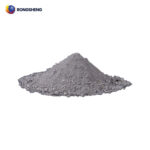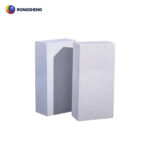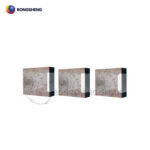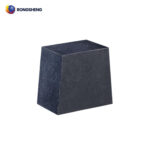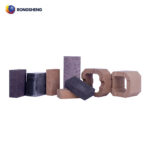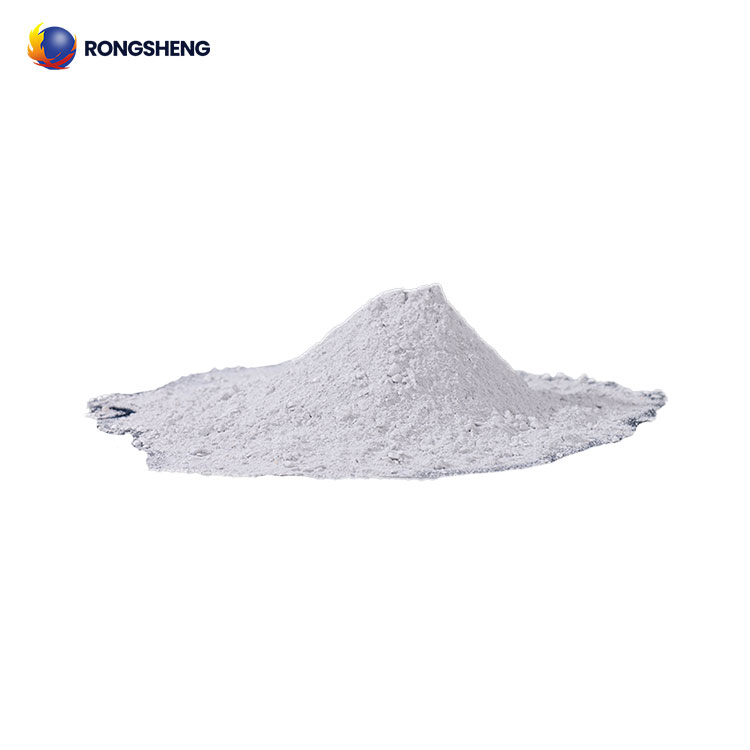
Corundum Mullite Castable
- High temperature strength.
- High load softening temperature.
- High temperature creep rate is small.
- Good chemical corrosion resistance is good.
- Good thermal shock resistance and structural shedding resistance.
We are Here to Help!
Email: sales@hy-refractory.com
WhatsApp: +86 185 3831 2977
Corundum mullite castable is a refractory castable made of dense corundum and mullite as aggregates and white corundum powder, α-Al2O3 micro powder, and mullite powder as fine powder. Corundum mullite refractory castable manufacturer, Rongsheng refractory material manufacturer, free price consultation, free design of refractory lining solutions.
Corundum Mullite Refractory Castable Refractory Introduction
Corundum-mullite refractory castables, the mullite raw materials selected in the ingredients are all artificially synthesized. It has the characteristics of high melting point, creep resistance, low expansion coefficient, thermal shock resistance and excellent corrosion resistance. When the temperature rises during use, the strength and toughness of mullite not only do not decrease, but are greatly improved, it is widely used in the refractory industry. But the difference between corundum and mullite lies in the hardness and density of corundum. Compared with mullite, the performance of corundum is better than that of mullite. After the castable is fired at high temperature, it has higher refractoriness, mechanical strength and higher load softening temperature. Therefore, corundum-mullite castables can be widely used in refractory products lining furnaces in various industrial furnaces with severe conditions such as high temperature, erosion, and erosion.
Functional characteristics of corundum mullite castables
- (1) It has the advantages of both corundum castable and mullite castable.
- (2) High high temperature strength, good thermal shock resistance and structural shedding resistance.
- (3) Good thermal shock resistance and high load softening temperature. The high temperature creep rate is small and the chemical corrosion resistance is good.
Corundum Mullite Castable Technique Data
| Item | RSCMC-1 | RSCMC-2 | RSCMC-3 | |
| Al2O3 ≥ | 70 | 75 | 85 | |
| SiO2 ≤ | 25 | 17 | 13 | |
| Fe2O3 ≤ | 1 | 1 | 1 | |
| Bulk Density g/cm3 ≥ | 2.7 | 2.8 | 2.9 | |
| 0.2MPa Refractoriness Under Load ℃ ≥ | 1450 | 1480 | 1500 | |
| Thermal Shock Resistance, Times, (900℃, water-cooling) ≥ | 25 | 25 | 25 | |
| Maximum Service Temperature ℃ | 1550 | 1550 | 1600 | |
| Linear Dimensional Change % ≤ | -0.3 | -0.2 | -0.2 | |
| Cold Crushing Strength Mpa ≥ | 110℃*24h | 100 | 110 | 120 |
| 1100℃*3h | 100 | 110 | 120 | |
| 1400℃*3h | 115 | 120 | 125 | |
| MOR ≥ | 110℃*24h | 15 | 15 | 15 |
| 1100℃*3h | 16 | 17 | 18 | |
| 1400℃*3h | 17 | 18 | 19 | |
Application of Corundum Mullite Castable
Corundum-mullite castables can be used in the front and rear kiln mouths of large cement kilns, coal injection pipes and other industrial kiln burners and linings. Rongsheng refractory castable manufacturer. Corundum Mullite Castable Refractory can also be used in steel furnace, cement kiln, glass furnace, iron making furnace, ceramic tunnel kiln and so on.
High-Temperature Performance of Corundum Mullite Castables
Corundum mullite refractory castable has the advantages of high softening temperature under load, good chemical stability and thermal shock resistance. Silicon carbide is widely used as a high-grade refractory raw material for the lining material of industrial kilns such as blast furnaces and heating furnaces. Among refractory materials, alkali resistance, corrosion resistance, high thermal conductivity, thermal shock resistance and crusting resistance have always been the focus. High-alumina mullite bricks containing an appropriate amount of silicon carbide have been widely used in the decomposition zone and transition zone of cement rotary kilns, and their service life is 3 to 4 times longer than that of high-alumina bricks. Foreign studies also believe that adding silicon carbide can reduce the formation of low-melting point feldspar mineral phases and make castables have certain self-healing properties.
Effect of adding silicon carbide to the properties of corundum-mullite castables
Rongsheng Refractory Materials Manufacturer conducted experiments to study the effect of adding 0~5% (w) silicon carbide powder on corundum-mullite castables. Among them, the effects of water demand, apparent porosity, linear change rate after burning, normal temperature flexural strength, normal temperature compressive strength and high temperature flexural strength are listed.
water demand.
As the addition amount of SiC powder increases, the water demand of the sample gradually increases. This is mainly because SiC powder particles are flaky and have poor hydrophilicity. To achieve the same fluidity, more water needs to be added.
Apparent porosity and linear change rate after burning.
As the additional amount of SiC powder increases, the apparent porosity of the dried samples shows a slight increasing trend, and the apparent porosity of the burned samples gradually decreases. As mentioned before, the water demand of the castable increases with the increase in the amount of SiC powder added, and the increase in the amount of water added leads to an increase in the apparent porosity of the dried sample. At high temperatures, the SiC surface is oxidized into a liquid phase SiO2 film, which promotes the sintering densification of the sample and is conducive to the formation of closed pores. In addition, the volume expansion effect of the oxidation of SiC to SiO2 and the volume expansion effect of the mulliteization reaction between SiO2 and alumina powder at 1100~1350°C will also crowd out the pores of the sample. The two work together to cause the apparent porosity of the burned samples to decrease with the increase in the amount of SiC powder added.
Apparent porosity of the sample after drying and burning. After being calcined at 1400°C for 3 hours, all samples shrank. As the addition amount of SiC powder increases, the linear shrinkage rate of the sample shows a decreasing trend. This is mainly because the volume expansion effect of SiC being oxidized to SiO2 and the volume expansion effect of the mulliteization reaction between SiO2 and alumina powder at 1100~1350°C can partially offset the post-burning shrinkage of the sample.
Room temperature flexural strength and room temperature compressive strength.
As the addition amount of SiC powder increases, the room temperature flexural strength of the dried samples does not change much, and the room temperature compressive strength shows a slight increasing trend. The normal temperature flexural strength and normal temperature compressive strength of the burned samples showed an increasing trend. The main reason why the normal temperature flexural strength and normal temperature compressive strength of the burned samples increased with the increase in the SiC powder addition was that the sintering densification degree of the samples increased. In addition, the mullite produced after SiC is oxidized to SiO2 and reacts with alumina powder in situ at 1100~1350°C also has a reinforcing effect on the sample.
High temperature flexural strength.
High temperature flexural strength of the sample after burning. The high-temperature flexural strength of sample T2 is significantly greater than that of sample T1. The high-temperature flexural strength of samples T2, T3, and T4 also increased sequentially. This is because the increase in sintering densification and the formation of mullite can not only improve the normal temperature strength of the sample, but also improve the high-temperature strength of the sample.
Add ≤5% (w) SiC powder to the corundum-mullite castable. As the addition amount of SiC powder increases, the water demand of the castable increases slightly, the linear shrinkage after burning decreases, and the apparent porosity of the sample after burning decreases. After burning, the normal temperature flexural strength, normal temperature compressive strength and high temperature flexural strength of the sample are improved.
How to improve thermal shock of corundum mullite castable?
Corundum-mullite castable has the characteristics of high load softening temperature and good creep resistance among high-temperature refractory materials. However, pure corundum products have less than ideal thermal shock resistance due to their large thermal expansion coefficient. Pure mullite products have a smaller thermal expansion coefficient and better thermal shock stability.
Corundum-mullite castable is made of mullite and corundum. When the mass ratio of mullite and corundum is 75:25, it is exactly at the combination point where the eutectic ingredient composition point appears at 1840°C in the SiO2-AL2O3 phase. If the thermal shock is increased, the best ratio of mullite to corundum is 75:25. Because the thermal expansion coefficient of mullite is smaller than corundum, and the thermal expansion coefficient of composite materials is definitely greater than the former. The thermal expansion coefficient between mullite and corundum causes thermal expansion inside the composite material, which will form micro-cracks, increase the material’s fracture absorption energy, and improve the thermal shock resistance of the castable.
If the ingredients are combined at the eutectic point, it will affect the creep resistance of the castable, and the creep rate is minimal at this time. When the ratio of mullite to corundum is about 75:25, the aggregate has a greater impact on the thermal expansion coefficient and thermal expansion mismatch of the product. When fine cracks occur in the castable and are subjected to thermal shock stress, the fine cracks will expand, and at the same time, the aggregate will undergo transgranular fracture and consume a large amount of energy. It not only inhibits the expansion of main cracks, but also affects the thermal shock stability of corundum-mullite castables.
Of course, corundum castables are also made, and their thermal shock resistance is also very good. The reason is that the different proportions of aggregate and binder lead to differences in thermal shock stability. The thermal expansion coefficient of corundum-mullite castables has a great influence on thermal shock stability. Microcracks caused by thermal expansion mismatch can actually improve the thermal shock resistance of castables.
To sum up, when the ratio of mullite and corundum is 75:25 in the process, the thermal shock stability is the best. The apparent porosity is about 20%, which is very beneficial to the thermal shock stability of the castable. Therefore, the apparent porosity of corundum mullite castable is controlled at about 20%, which further improves the thermal shock stability.
Buy Corundum Mullite Castable from Rongsheng Company
Corundum Mullite Castable is a kind of high strength unshaped refractory materials for sale in Rongsheng Company, which can be used in cement kiln. Corundum Mullite Castable Refractory can perform high properties such as high crushing strength, high temperature stability, thermal shock resistance, wear and chemical erosion resistance in lining of large power station boiler and other high temperature equipments. Contact Rongsheng for free quote and samples.

